The Language of Light
Merriam Webster’s Dictionary tells us:
Light (noun) līt. 1 a: something that makes vision possible. b: the sensation aroused by stimulation of the visual receptors. c: electromagnetic radiation of any wavelength that travels in a vacuum with a speed of 299,792,458 meters (about 186,000 miles) per second; specifically: such radiation that is visible to the human eye.
Beyond this definition, how can we precisely describe, quantify, and analyze the electromagnetic waves (visible and invisible) that surround us? The radiation of light is made up of sub-atomic particles called photons, which we can describe by their energy or, inversely, by their wavelength. Fun fact: unlike other elementary particles (i.e., electrons, neutrons, and protons), photons have zero mass. They are simply carriers of electromagnetic radiation.
When we look at the entire spectrum of electromagnetic radiation in the context of the wavelength, we have very energetic gamma rays on one end (short wavelength), all the way to low-energy microwaves and radio waves on the other (long wavelength). The very small band in the middle of the spectrum is the range of light that is visible to the human eye. Visible light has wavelengths within the range of about 380 nanometers (nm) to 830 nm, bounded by ultraviolet (UV) at the low end of the range and infrared (IR) at the high end.

The top bar shows the full spectrum of electromagnetic radiation, including invisible wavelengths such as X-rays, microwaves, and radio waves, plotted in order of increasing wavelength. The bottom bar is an expanded view of visible light: the narrow range of the electromagnetic spectrum that the human eye can perceive.
One of the ways we can define light coming from any light source (a lightbulb, the sun, etc.) is by it’s spectral power distribution (SPD). SPD is a measurement of the energy (Watts) that is output at each wavelength. The SPD of any light source can be plotted graphically:
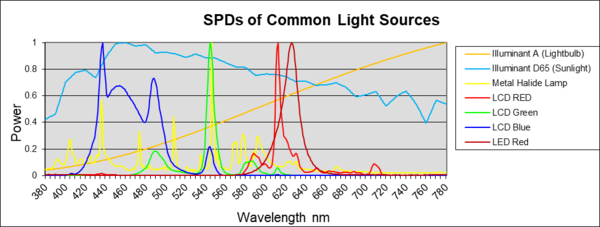
SPDs of common light sources. Illuminant A, for example, is a broad band light source, with light emitted at every wavelength, increasing with longer wavelengths. In contrast, a Red LED has a very narrow spectrum, emitting light primarily between 600 and 630 nm.
Photopic Response Curve
The human eye does not see the entire SPD of a light source; we see only the resulting color and brightness. In fact, two light sources could appear the same to the human eye, but have different SPDs. If our goal is to describe how a human perceived a light source, we can use the principles of Colorimetery and Photometry. The rest of this blog post will focus just on the perceived brightness (photometric) and leave color for a future date.
Photometry is the science of the measurement of light as perceived by the human eye, i.e., the visible spectrum. Within the visible spectrum, the human eye’s response is weighted by what's called the 'Photopic Response Curve'.
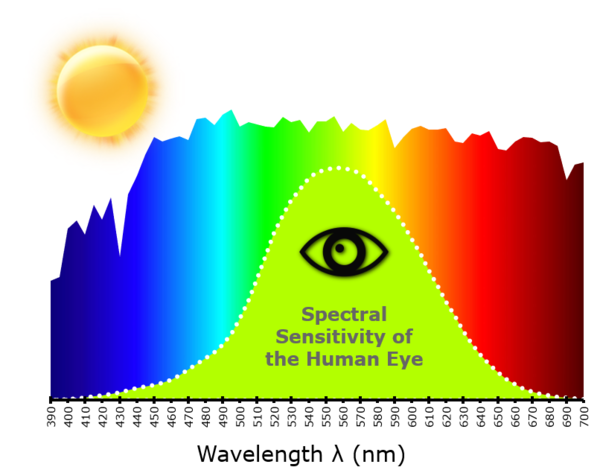
The Spectral Power Distribution of sunlight (the rainbow area of the graph, which represents approximate colors at each wavelength) from 390-700 nm, overlaid with the spectral sensitivity of the human eye (green curve), known as the photopic curve.
The curve in the graph above is the photopic response curve. The peak of the curve indicates the greatest sensitivity of the human eye is in the green and yellow wavelengths, which correspond with the peak output of the sun. Our eyes are most sensitive where we receive the most radiation (a maximum luminous efficiency of approximately 555 nm).
Quantifying Light
There is a defined mathematical language that quantifies brightness and color variation as perceived by a typical person, called the “standard human observer.” Photometric units measure light (the visible wavelengths) weighted by the human eye response; radiometric units measure energy (encompassing all electromagnetic wavelengths, including visible light), and is not weighted to the human response. Having defined language and standards enables us to measure and reproduce light sources to exact specifications.
Imagine you were designing a luminaire—a light bulb set into some kind of housing. One of the first things to determine is the total amount of light that’s emitted by the light source, integrated over the entire angular span of the light. This is called luminous flux, and is measured in units of “lumens” (lm), a photometric unit of measurement.
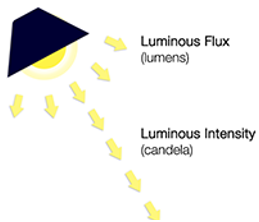
Luminous flux is a measure of the total output of a light source, determined by integrating its intensity over its angular span. Measured in lumens (lm).
Now you might want to assess how your luminaire would perform in a room and how the light would be distributed in the space. For example, is it a widely diffuse light that brightens the whole room, or a spotlight that shines primarily on a specific area. Luminous intensity will tell you the amount of light shining from the luminaire in a given direction. Luminous intensity is measured in candela (cd), which equals lumens per steradian (sr), the unit of measure for a three-dimensional angle.
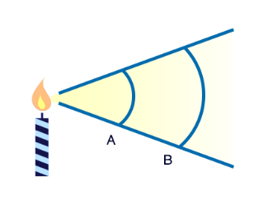
Luminous Intensity is the amount of light emitted by a light source within the range of a three-dimensional angular span. Measured in candela (cd).
Illuminance is the next element we can measure: the amount of light that shines onto a surface per unit of area. It’s measured as the number of lumens per square meter (lm/m2), also called lux.
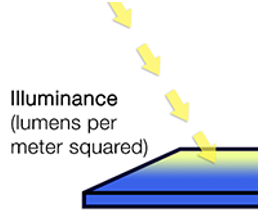
Illuminance is the amount of light that shines on (incident on) a surface per unit area. Measured in lumens per square meter (lm/m2) or lux.
For example, if we were designing this luminaire as a ceiling fixture in a hospital operating room, we might be concerned about how much light will shine onto the table vs. how much will fall on the floor. In a field like the medical industry, lighting specifications can be heavily regulated to ensure that surgeons have enough light—and the right kind of light—to work effectively (certain colors of light can make it harder to distinguish flesh and tissue).
The last of the major photopic measurements is luminance. It is the only one that includes the presence of a theoretical observer. Luminance measures the amount of light that shines in a given direction (i.e., to a human’s eye), whether reflected back from a surface, or emitted from a display screen. It’s measured by the number of candelas (luminous intensity) per square meter (cd/m2)
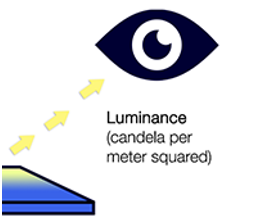
Luminance is the amount of light emitted from a light source or reflected back from a surface in a given direction. Measured in candelas per square meter (cd/m2).
Looking at the whole picture, we can see the interrelationship of these different light measurements:
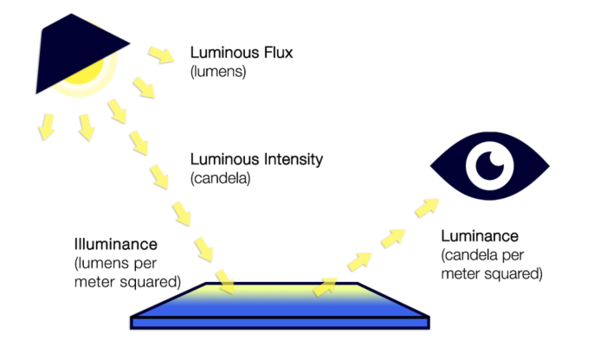
There is one other term that you might have heard in the display industry—or from the television salesperson at your local electronics store—and that’s “nits.” This term is used to describe the brightness of a display screen (the amount of light emitted from it). Essentially, 1 nit = 1 cd/m2.
Radiometric Measurement
So what about all of the wavelengths beyond the range of visible light? To characterize the electromagnetic spectrum, there is a set of standard radiometric measurements that parallel the similarly named photopic measurements defined above:
Radiant flux – measures the total amount of electromagnetic energy emitted by a source, measured in Watts (W). This is sometimes also called radiant power.
Radiant intensity – the total amount of energy emitted within a three-dimensional angle, measured as the number of Watts per steradian (unit solid angle). You may recall that luminous intensity is measured in candela, which is the number of lumens per steradian.
Irradiance – measures the amount of energy that lands on a surface, measured as Watts per square meter (W/m2).
Radiance – The energy reflected, transmitted or received by a surface, per angle per area. This is a directional quantity, measured as Watts per steradian per square meter (W/sr·m2)
Radiance and luminance are both sometimes also confusingly called "intensity", but being specific about the nature of what you want to measure (e.g., the output of a light source vs. light measured from the point of view of an observer) is more precise. To summarize:
| Quantity Measured | Photometric | Radiometric |
|---|---|---|
| Total light (energy) output | Luminous flux. Measured in lumens (lm) | Radiant flux. Measured in Watts (W) |
| Light from a direction | Luminous intensity, measured in candela (cd). 1 cd = 1 lumen/steradian | Radiant intensity. Watts per steradian (W/sr) |
| Light incident on a surface | Illuminance = lux. 1 lux = 1 lumen/meter | Irradiance. Measured as Watts per square meter (W/m2) |
| Brightness | Luminance. Measured in candela per square meter (cd/m2) or nits. 1 nit = 1 cd/m2 | Radiance. Measured as Watts per square meter per steradian (W/sr·m2) |
Measuring Visible Light
For a wide range of products—such as light bulbs, automobile headlamps, and display screens—obtaining precise measurements of light output is critical for quality control and ensuring proper performance. Radiant’s imaging photometers and colorimeters are designed to measure light and color, matching the perception of the human eye. Our imaging systems measure light in displays, illuminated keyboards, backlit panels and components, LEDs and LED arrays, and other light sources.
Radiant’s ProMetric Y imaging photometers are applied across industries to quantify and evaluate light-emitting devices for a range of values including: luminance, illuminance, luminous intensity, and total luminous flux, and can output measurement results in IES file format that’s standard in some industries.
Our ProMetric I imaging colorimeters can measure CIE chromaticity, correlated color temperature (CCT), light and color uniformity, and contrast. These values can be used in device characterization and design in lab settings, and compared against production values for quality control on the line.
To learn more about light, the color spectrum, and human-centered measurement, view the webinar: Principles of Light & Color Measurement.

Join Mailing List
Stay up to date on our latest products, blog content, and events.
Join our Mailing List
